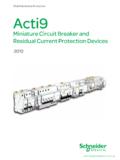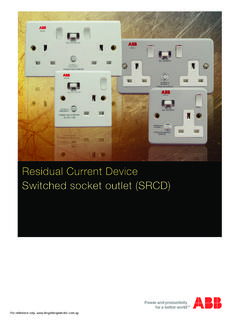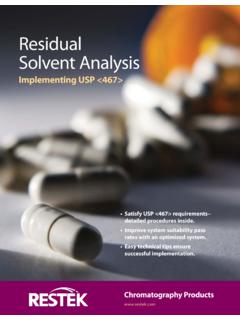Transcription of 290 Residual Neuromuscular Blockade - Anaesthesia UK
1 Sign up to receive ATOTW weekly - email ATOTW 290 residual neuromuscular blockade , 26/08/2013 Page 1 of 8 Residual Neuromuscular Blockade Anaesthesia TUTORIAL OF THE WEEK 290 26TH AUGUST 2013 Dr Daniel Moi, Anaesthetic Registrar Royal North Shore Hospital, Australia Correspondence to QUESTIONS Before continuing with this tutorial, try to answer the following questions. The answers can be found at the end of the article, together with an explanation. 1. Which of the following is most reliable in assessment of Residual Neuromuscular Blockade ? a. Train of four ratio < b. Train of four ratio < c. Clinical signs d. Patient symptoms 2. When monitoring the adductor pollicis muscle, which statements are correct? a. The thenar branch of the median nerve is being stimulated b. The positive (red/white) electrode should be placed proximally on the forearm c.
2 It is more accurate to use tactile than visual assessment for twitches and fade d. Assessment using this muscle correlates well with diaphragmatic function 3. Select true or false for these statements a. Long-acting Neuromuscular blockers are relatively low risk for Residual Neuromuscular Blockade b. For safest results, neostigmine should be given at all train of four ratios c. Sugammadex offers additional, but limited, benefits in reversal of Neuromuscular Blockade d. Residual Neuromuscular Blockade is an uncommon problem of minor consequence DEFINTION AND CONTEXT Residual Neuromuscular Blockade can be defined by inadequate Neuromuscular recovery as measured by objective Neuromuscular monitoring. It is also referred to as Residual paralysis, Residual curarisation, and Residual Neuromuscular block. More specifically, recent opinion suggests a definition of inadequate train of four recovery of less than (TOF < )1.
3 The train of four method of peripheral nerve stimulation was introduced in the 1970s. The use of a threshold ratio of was derived from several studies aiming to establish the concept of acceptable recovery . This ratio was derived from certain clinical signs and subjective Neuromuscular monitoring including the ability of patients to open their eyes widely, cough, protrude their tongue, attain vital capacity breaths of 15-20 mL/kg, and sustain tetanic stimulation without fade for 5 seconds1. With advances in monitoring and continued studies, a TOF < is now considered as Residual Neuromuscular Blockade . This more stringent ratio was arrived at after several studies demonstrated an increased risk of aspiration and pharyngeal dysfunction at TOF < , and impaired inspiratory flow and partial airway obstruction at TOF < Sign up to receive ATOTW weekly - email ATOTW 290 residual neuromuscular blockade , 26/08/2013 Page 2 of 8 It should be noted that there is a large variability between patients.
4 Some patients may display obvious muscle weakness despite a TOF> , whilst complete clinical recovery of muscle strength can be observed in others with a TOF< Importantly, distressing symptoms in awake patients may be observed even at subtle levels of Neuromuscular block of TOF > On a practical level, the concept of adequate Neuromuscular recovery is intended as the return to a basline muscular function, particularly the ability to breathe normally, maintain a patent airway, and retain protective airway reflexes. INCIDENCE It has been difficult to prove the association of Residual Neuromuscular Blockade with significant morbidity and mortality. This is largely due to the relatively low incidence of major adverse outcomes after Anaesthesia and surgery. There are also a limited number of randomized controlled trials concerning this topic, and inadequate numbers of well designed cohort studies.
5 There are many variables in clinical practice that will influence Residual Neuromuscular Blockade , which has led to a heterogenous pool of evidence. However, current estimates are that around 40% of post-operative patients (who have been paralised) arrive in PACU with TOF < , and 12% with TOF < This is in comparison to estimates in the 1970s, where around 45% of patients arrived with TOF < Based on studies examining morbidity from Residual Blockade , a rough estimate of 1-3% of these patients would be expected to develop clinically aparent events1. Considering the large percentage of patients estimated to have Residual Blockade , it could be easily inferred that most patients tolerate Residual block of modest depth without untoward results. However, there exists a small proportion of patients, particularly those with existing limited physiological reserve where Residual Neuromuscular Blockade has serious consequences.
6 ADVERSE EFFECTS OF Residual Neuromuscular Blockade The following tables detail the implications of Residual Neuromuscular Blockade (these are more illustrative than exhaustive)1. Table 1: Physiological changes Impaired muscle tone and coordination Upper airway pharyngeal and oesophageal muscles Increased risk of aspiration Increased risk of airway obstruction Laryngeal muscles Increased risk of aspiration Impaired phonation Impaired cough Respiratory muscles Impaired ventilation and oxygenation Impaired function of other muscles throughout the body Table 2: Clinical implications Symptoms and signs of muscle weakness Difficulty breathing Generalised weakness Difficulty speaking Visual disturbances Patient distress Immediate critical respiratory events in PACU Post- operative hypoxaemia Upper airway obstruction Later respiratory events Prolonged ventilator weaning Post- operative pulmonary complications (eg.)
7 Atelectasis, pneumonia) Sign up to receive ATOTW weekly - email ATOTW 290 residual neuromuscular blockade , 26/08/2013 Page 3 of 8 INVESTIGATIONS The ideal test of Neuromuscular recovery would not require an awake, cooperative patient and would be easily applied, reliable and inexpensive. Clinical criteria for evaluating adequacy of muscle function include: assessment of a patient s ability to maintain adequate head lift, jaw clench, grip strength, and tidal volume. These are unreliable predictors of Neuromuscular recovery. For example, it is possible to maintain a 5 second head lift with TOF < In addition, many of these tests are not specific for respiratory function. The table below describes the diagnostic value of 2 common clinical tests2. Table 3: Diagnostic attributes of clinical tests of Neuromuscular recovery Sensitivity Specificity Positive predictive value Negative predictive value Inability to lift head for 5 seconds Inability to perform sustained hand grip for 5 seconds Train-of-four Neuromuscular monitoring is commonly conducted with a subjective measurement, either as a simple train of four count (TOFC) or train of four ratio (TOF).
8 The latter refers to when there is already a TOFC of 4, and subsequent assessment is made for fade in T4 compared to T1. Tactile evaluation (movement of patient s thumb against the observer s fingers) is more accurate than visual assessment2. However, neither are reliable in detecting fade (37% versus 57% in one study6), and the majority of evaluators are unable to detect fade when TOF ratios > Double Burst Stimulation (DBS) is another method of Neuromuscular monitoring, but is also commonly measured in a subjective This improves detection of fade to up to which is significant, but doesn t eliminate the incidence and degree of Residual Neuromuscular blockade8. Objective measurement of Neuromuscular monitoring is the only way of accurately assessing Residual Neuromuscular Blockade . In general, it is conducted via quantitative measurement of the strength of contraction of a peripheral muscle (eg.)
9 Adductor pollicis muscle in thumb) in response to peripheral nerve stimulation (eg. ulnar nerve at wrist) produced by 2 stimulating electrodes. Each measurement technique measures the force of contraction, either directly or by a factor that is proportional to force. Table 4: Different types of objective Neuromuscular monitoring devices (photos courtesy of Dr Sorin J Brull, MD, and Dr Thomas M Hemmerling, MD.) DEVICE NOTES Mechanomyography (MMG) Sensor: Force transducer Measures: Force of contraction Widely considered gold standard Rarely used clinically because of elaborate setup and bulk of equipment Force transducer Electrodes Sign up to receive ATOTW weekly - email ATOTW 290 residual neuromuscular blockade , 26/08/2013 Page 4 of 8 Electromyography (EMG) Sensor: Electrodes Measures: Amplitude of compound muscle action potential Affected by electocautery Considered as gold standard by some experts Kinemyography (KMG) Sensor: Piezoelectric polymer sensor in groove between thumb and index finger Measures.
10 Movement of muscle (which generates voltage in sensor) Less reproducible results than EMG Phonomyography (PMG) Sensor: High- fidelity narrow- bandwidth microphone placed alongside muscle Measures: Sound intensity Low clinical use and unclear future Accerelomyography (AMG) Sensor: Piezoelectric crystal Measures: Acceleration of muscle (which generates voltage in crystal) Reliably detects TOF ratios Can overestimate compared to EMG PRACTICAL NERVE STIMULATOR TIPS With multiple options for site and method of Neuromuscular monitoring, the question becomes which site is best for establishing depth of paralysis. Two sites are commonly utilized, each having its own advantages. Measurment at the adductor pollicis correlates well with the tone in the upper airway and upper oesophageal muscles4.
















![arXiv:1707.02921v1 [cs.CV] 10 Jul 2017](/cache/preview/a/1/f/6/e/b/6/7/thumb-a1f6eb6760e3138078c3c6131fc3f8e7.jpg)

